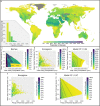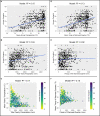Revising the global biogeography of annual and perennial plants
- PMID: 37938778
- PMCID: PMC10830411
- DOI: 10.1038/s41586-023-06644-x
Revising the global biogeography of annual and perennial plants
Erratum in
-
Publisher Correction: Revising the global biogeography of annual and perennial plants.Nature. 2024 Feb;626(8000):E16. doi: 10.1038/s41586-024-07122-8. Nature. 2024. PMID: 38297131 Free PMC article. No abstract available.
Abstract
There are two main life cycles in plants-annual and perennial1,2. These life cycles are associated with different traits that determine ecosystem function3,4. Although life cycles are textbook examples of plant adaptation to different environments, we lack comprehensive knowledge regarding their global distributional patterns. Here we assembled an extensive database of plant life cycle assignments of 235,000 plant species coupled with millions of georeferenced datapoints to map the worldwide biogeography of these plant species. We found that annual plants are half as common as initially thought5-8, accounting for only 6% of plant species. Our analyses indicate that annuals are favoured in hot and dry regions. However, a more accurate model shows that the prevalence of annual species is driven by temperature and precipitation in the driest quarter (rather than yearly means), explaining, for example, why some Mediterranean systems have more annuals than desert systems. Furthermore, this pattern remains consistent among different families, indicating convergent evolution. Finally, we demonstrate that increasing climate variability and anthropogenic disturbance increase annual favourability. Considering future climate change, we predict an increase in annual prevalence for 69% of the world's ecoregions by 2060. Overall, our analyses raise concerns for ecosystem services provided by perennial plants, as ongoing changes are leading to a higher proportion of annual plants globally.
© 2023. The Author(s), under exclusive licence to Springer Nature Limited.
Conflict of interest statement
The authors declare no competing interests.
Figures










References
-
- Friedman J. The evolution of annual and perennial plant life histories: ecological correlates and genetic mechanisms. Annu. Rev. Ecol. Evol. Syst. 2020;51:461–481. doi: 10.1146/annurev-ecolsys-110218-024638. - DOI
-
- Raunkiær, C. Über das Biologische Normalspektrum (Andr. Fred. Host & Son, Kgl. Hof-Boghandel, 1918).
-
- Whittaker, R. H. Communities and Ecosystems (Macmillan, 1975).
Publication types
MeSH terms
LinkOut - more resources
Full Text Sources
Research Materials

